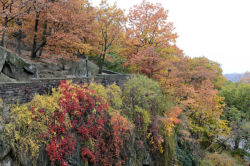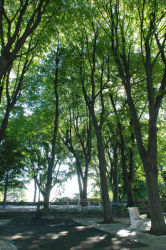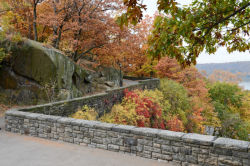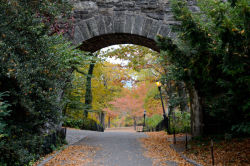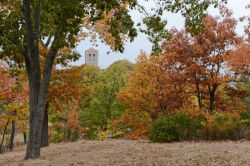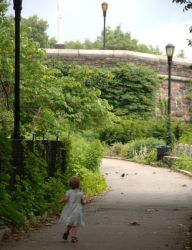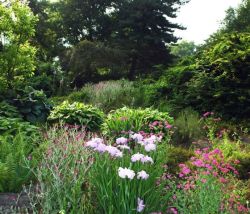Fort Tryon Park
Fort Tryon Park
Originally inhabited by the Weckquaesgeek Tribe, who lived in the area until the early 17th century, this densely forested high ground at the northern end of Manhattan was “Lang Bergh” or Long Hill to the early Dutch colonists. The Continental Army called the strategic series of posts along the Hudson River “Fort Washington” during the summer of 1776, until Hessian mercenaries fighting for the British forced the troops to retreat. The British then renamed the area for Sir William Tryon (1729–1788), Major General and the last British governor of colonial New York.
Margaret Corbin (1751–1800Α), for whom the park’s drive and the circle near the entrance are named, took control of her fallen husband John’s cannon during the 1776 attack and was wounded during the clash. In 1977, the City Council named the drive in her honor.
During the 19th century, wealthy New Yorkers built elegant estates around the Fort Tryon area, the most notable being the house of Cornelius K.G. Billings, a wealthy horseman from Chicago. From 1901 to 1905, Billings reportedly spent more than $2 million building his Tryon Hall mansion. In 1909, Billings funded a stele erected at the apex of the park memorializing Corbin and the Continental Army’s defense of the site in honor of the Hudson Fulton Celebration.
In 1917, John D. Rockefeller, Jr. (1874–1960) bought the Billings mansion and began developing the property, employing the Olmsted Brothers architectural firm to help him realize his vision for the site. Rockefeller even purchased land on the New Jersey side of the Hudson—now known as the Palisades State Park—to preserve Fort Tryon’s stunning views. Although the Billings mansion burned to the ground in 1925, a small frame and stucco gatehouse from the original property remains located just west of Corbin Circle. Rockefeller donated the land to the City in 1931, and it was designated parkland the same year.
Frederick Law Olmsted Jr. (1870–1957), son of the co-designer of Central and Prospect Parks, spent four years transforming the site’s rocky topography and thin soil into a manicured landscape. Olmsted designed Fort Tryon Park with promenades, terraces, wooded slopes, and eight miles of pedestrian paths, careful to preserve open areas and the spectacular views of the Hudson and the Palisades. He noted in 1927 that this park had one of the few unspoiled river views in Manhattan.
The Cloisters opened in the north end of Fort Tryon Park in 1938 after Rockefeller bought sculptor George Grey Barnard’s (1863–1938) collection of medieval art. Inspired by Romanesque monasteries, the museum includes several cloisters, or courtyards, from actual French monasteries. Now a branch of the Metropolitan Museum of Art, it was designated an official New York City landmark in 1974.
The plaques and monuments in the park commemorate the 1776 siege and Rockefeller’s gifts, and several modern sculptures connect the park’s historic past to its present. In 1983, Fort Tryon Park was designated an official City landmark, and a plan was developed the following year to fully renovate the park. The park’s Heather Garden was one of the first projects slated for renovation. By the 1980s, the garden had become overgrown. Thanks to volunteers and the Greenacre Foundation, Parks completed a three-year restoration of the garden and reopened long-lost views of the Hudson and the Palisades in 1988.
Fort Tryon contains two notable playgrounds. In 1985, Parks dedicated a playground at the southern end of the park for Jacob Koppel Javits (1904–1986), the noted legislator from the Lower East Side. The Anne Loftus Playground, which was named in 1990 for Anne Susan Cahill Loftus (1925–1989), an Inwood resident and district manager of Community Board 12, was part of the original Olmsted design.
Containing one of the highest points in Manhattan, Fort Tryon Park towers above the Hudson River, offering magnificent views of the Palisades and the lower Hudson Valley that challenge the notion that Manhattan’s best vistas are experienced from its skyscrapers.
Check out your park's Vital Signs
Clean & Safe
Green & Resilient
Empowered & Engaged Users
Share your feedback or learn more about how this park is part of a
Vital Park System


